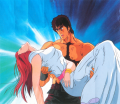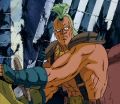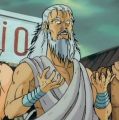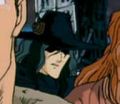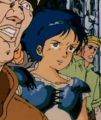Hokuto no Ken (1986 movie): Difference between revisions
Mobanewbie (talk | contribs) (replaced the uncut scenes video with a better quality one ( although the part where that guy's skull was visible does not fully appear ) but it's the same video with a higher quality) |
No edit summary |
||
| Line 36: | Line 36: | ||
Another change in the ending made in the home video versions was the addition of a black title card with the kanji 完 (''kan'') for "The End" after the closing credits. Reportedly this title card was not present in the a theatrical version and was only added on the home video releases after plans for a sequel were abandoned. | Another change in the ending made in the home video versions was the addition of a black title card with the kanji 完 (''kan'') for "The End" after the closing credits. Reportedly this title card was not present in the a theatrical version and was only added on the home video releases after plans for a sequel were abandoned. | ||
<div class="thumb tright"> | |||
</div> | <div class="thumb tright"> </div> | ||
===Censorship=== | ===Censorship=== | ||
<div class="thumb tright"> | <div class="thumb tright"> | ||
[[File:Hokuto No Ken Movie - Uncut scenes from the Italian VHS (High Quality)|thumb|425x425px]] | [[File:Hokuto No Ken Movie - Uncut scenes from the Italian VHS (High Quality)|thumb|425x425px]] | ||
| Line 135: | Line 137: | ||
| [[w:c:yamato:Taro Ishida|Tarō Ishida]] || [[w:c:startrek:Jeff Corey|Jeff Corey]] | | [[w:c:yamato:Taro Ishida|Tarō Ishida]] || [[w:c:startrek:Jeff Corey|Jeff Corey]] | ||
|} | |} | ||
==Techniques featured== | |||
===Pressure points=== | |||
*'''Kyousetsu''' (拒節 (きょせつ)) - Used on Jagi. Note that this was named in the movie while the Manga and Anime adaptation doesn't. | |||
==Trivia== | ==Trivia== | ||
Revision as of 11:24, 24 March 2018
| Fist of the North Star | |
|---|---|
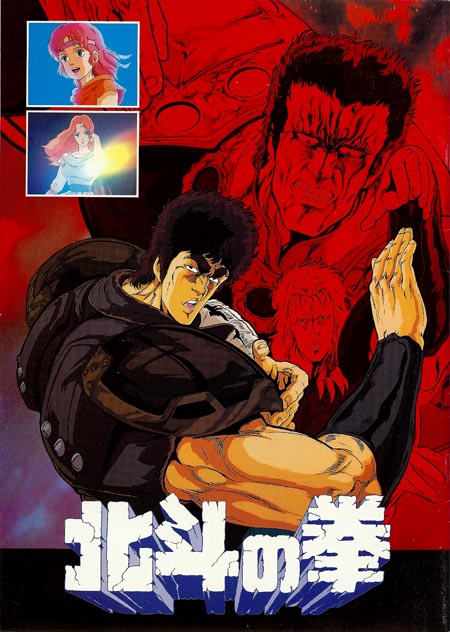 Theatrical pamphlet distributed in 1986 | |
| Directed by | Toyoo Ashida |
| Produced by | Toei Animation |
| Written by | Susumu Takaku |
| Narrated by | Tarō Ishida |
| Starring | Akira Kamiya |
| Music by | Katsuhisa Hattori |
| Cinematography | Tamio Hosoda |
| Editing by | Masaaki Hanai |
| Studio | Toei Animation |
| Distributed by | Toei Company |
| Release date(s) | March 8, 1986 |
| Running time | 110 minutes |
| Country | Error creating thumbnail: /bin/bash: line 1: convert: command not found Japan |
| Language | Japanese |
| Gross revenue | ¥1,800,000,000 |
An animated feature film version of Fist of the North Star was produced by Toei Animation, which premiered in Japan on March 8, 1986.[1] The movie was intended to be a big-screen treatment of the manga, and avoid the watering-down of violence that came with the TV series. An English-dubbed version produced by Streamline Pictures was first released in 1991 in the USA and 1994 in the UK and Australia by Manga Entertainment. A New Zealand release was never scheduled by Manga Entertainment so it never had an official release there.
Plot differences from the manga and TV series
In a notable deviation from the series, the film finds time to begin with a detailed peek at the Earth as it was before and during the fabled nuclear devastation. Starting with a calm, surreal look at various points of Mother Nature, a brief on-screen message then informs the audience of the imminent calamity, followed by unsettling Barefoot Gen-esque scenes of human life consumed in flame.
The film follows the storyline of the manga from Kenshiro's defeat at the hands of Shin to the first battle with Raoh, although certain liberties were taken to tell the story in a condensed form. For example, Toki, the second of the four Hokuto Brothers, is never seen nor mentioned, while Shin and Rei are the only Nanto Seiken masters to appear in the film. Although Yuria's Nanto heritage is mentioned through out the movie in the Japanese version, her role as the Last Nanto General is downplayed. Her fate has also been altered from the original story, wherein this time she is kidnapped by Raoh instead of jumping off Shin's palace to resurface later as the Last Nanto General. She disappears during the final battle and her survival remains ambiguous at the conclusion of the film. Mamiya, Rei's love interest, is never seen, partly because Yuria is the heroine in her place. Raoh serves as the main antagonist, with Jagi and Shin as the other two major villains. Many other villains from the manga and anime, such as the Colonel and Jackal, only make cameo appearances as minor henchmen with some of the notable fight scenes involving Zeed, Heart, the Kiba Daiō and Uighur. Altogether the order and occurrences of the original story were almost completely rewritten.
Alternate versions
Endings
There were two endings produced for the film. The original ending shown in the theatrical version has Raoh emerging victorious over Kenshiro, but sparing his life, leaving him to protect Lin. An alternate ending was produced that end the fight in a draw, which is the ending featured in all the home video releases of the film in Japan (although, the 1995 film comic adaptation depicts the original ending). All the international cuts feature the original ending. The reason for the change in ending has never been officially revealed, although it is believed that fans were unsatisfied with Kenshiro losing the final fight.
The 2008 Japanese DVD release of the film features the theatrical ending as a bonus feature, but only on the first print run. Because the revised ending was produced on a different film stock, it did not underwent the same remastering treatment that the rest of the movie did (including the original ending), resulting in a drastic drop in visual quality when the scene is played (on the 1:40:45 time mark).
Another change in the ending made in the home video versions was the addition of a black title card with the kanji 完 (kan) for "The End" after the closing credits. Reportedly this title card was not present in the a theatrical version and was only added on the home video releases after plans for a sequel were abandoned.
Censorship
Most of the film's violent scenes, particularly those involving close-ups of human decapitations and butchering, were toned down through the use of a discoloration and blurring effect in most versions of the film including the Japanese theatrical release (according to circumstancial accounts). This is evident in one of the preview trailers, which features a shot of Rei slicing the head of one of Fox's henchmen without the blur. No uncensored version of the film was ever released in Japanese home video and it is unknown is an uncensored version was ever shown in theaters. However, the Italian dubbed version, released on VHS in 1993 by Granata Press and re-released in 1996 by Dynamic Italia, was based on a cut that has the following scenes uncensored.
- The scene when Shin engraves the seven wounds on Kenshiro's chest (as well as the later flashback of the same scene when Kenshiro is resting in Lin's village) has no discoloration when Shin is making the wounds with his fingers. There's also no blur in the shot when Shin lifts his bloodied finger next to his face.
- The scene in which one of Zeed's underlings explodes in front of Bat, spilling blood on his face, has no discoloration.
- When Raoh's army is marching into the city of Cassandra, there's short scene in which Galf crushes the head of a villager whose chanting is off-key. In the censored version, it cuts to a shot of Raoh's army just when Galf grabs the villager's head and then cuts back to Galf after the villager's body falls to the ground. This is notable for being the only known scene that was outright edited from the movie rather than being blurred out.
The other scenes of violence, including the aforementioned head slicing shot with Rei, are still blurred out in the Italian version. A fan-edit was released online which inserts all the known uncensored scenes into the 2008 remastered version.
Credits
The 1991 English dubbed version by Streamline Pictures is the only international version which features credits in its own language, rather than simply retaining the Japanese credits, crediting not only the original Toei Animation staff, but also the cast and crew who worked on the English dub. This suggests that Streamline Pictures had access to clean versions of these animated sequences to create their own credits. Despite this, no credit-less versions of these sequences were ever released publicly.
Cast
Techniques featured
Pressure points
- Kyousetsu (拒節 (きょせつ)) - Used on Jagi. Note that this was named in the movie while the Manga and Anime adaptation doesn't.
Trivia
- Kenshiro doesn't announce any of his trademark techniques throughout the movie.
- The animators studied human anatomy to make the deaths look realistic.
- Mr. Heart is referred by the name "Elephant" (エレファント) on the character model sheets and early promotional materials.[2] This planned name change was presumably done to go along with the animal motif of Fox and Jackal, who were rewritten to be Jagi's henchmen along with Heart. However, he retains his original name in the finalized film.
- The February 3, 1986 issue of Weekly Jump (issue no.8 of 1986) features a preview of the movie on the other side of the issue's Hokuto no Ken spread.[3] The preview lists a slightly different lineup of matches compared to the ones actually featured in the actual movie. Most notably it lists the third match as "Kenshiro vs. Devil Rebirth", the latter being a character who is not in the movie. Other matches not in the final movie include "Shin vs. Raoh" (the actual fight is alluded in the movie, but only the outcome is shown), "Rei vs. Kiba Daiō" and "Kenshiro vs. Uighur".[4]
- Along with a few Hokuto no Ken digest tapes releases, the film is one of the few medias to feature Stereo audio.
Gallery
-
-
-
-
va Banjō Ginga
-
va Yasuo Tanaka
-
va Yūsaku Yara
-
va Kōzō Shioya
-
va Reiko Suzuki
-
va Yasuo Tanaka
-
va Jōji Yanami
-
Katsuhisa Hattori's composition "Le Rhone" was used as Lin's theme in the movie.
References
- ↑ "Hokuto no ken (1986)". Imdb.com. Retrieved on 2008-09-14.
- ↑ "「北斗の拳」で美しいと言えば… (Razor Sharp)".
- ↑ "【ジャンプ黄金期】1986年『第8号』2月3日号".
- ↑ "劇場版 北斗の拳のパンフレットを入手!! you は shock".
External links
- Hokuto no Ken (film) at Anime News Network's Encyclopedia
- Hokuto no Ken at the Internet Movie Database
- Official site of the 25th anniversary DVD release by Toei (Japanese)

